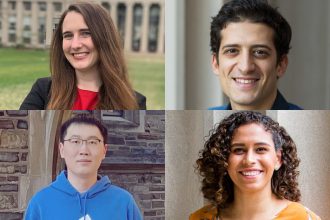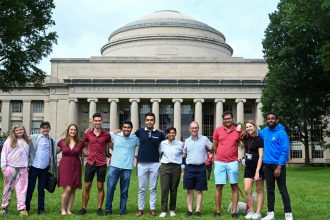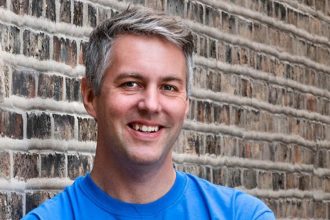Diagnosing cancer with a barcode-inspired test
As Dana Al-Sulaiman peers into a microscope, a row of dots appears on a slide. These dots can help provide a cancer diagnosis. Al-Sulaiman was inspired by barcodes found on consumer products.
A pet brand on a mission
Two years ago, as Rhett James was starting a dual-degree MBA/master's degree in city planning, a chance meeting with Leyou Tameru, a legal consultant based in Ethiopia, would take him down an unexpected path. An architect by trade, James had an eye for design, but never anticipated that he would go into consumer goods. When casually discussing small business ideas with Tameru, the pair landed on a concept that stuck with them: an inclusive, social impact pet brand inspired by African and Black culture.
Meet this year’s MathWorks Fellows: A three-part series, III
When the Perseverance Rover landed on Mars last February, it carried with it an oxygen generation experiment called MOXIE. The instrument uses electrolysis to split oxygen out of a Martian atmosphere predominantly composed of carbon dioxide. When the system is initiated, it can produce enough oxygen for one human to breathe for a little more than ten minutes.
Faster than a snail
On September 12, the student-led group, MIT Hyperloop III will be presenting a machine learning-augmented drilling technology at Elon Musk’s ‘Not-A-Boring’ competition to be held in the Mojave Desert. The competition is sponsored by Musk’s The Boring Company, which he founded to pursue hyperloop technology. MIT Hyperloop III was selected as one of twelve groups, the “Digging Dozen,” to participate in the competition out of an applicant pool of over 400 teams.
Recognizing seven years of the MIT University Center for Exemplary Mentoring (UCEM)
MIT University Center for Exemplary Mentoring (UCEM) was founded in 2015 with an Alfred P. Sloan Foundation grant that centers on the recruitment, retention, and academic success of underrepresented minority doctoral students in five departments in the School of Engineering: Biological Engineering, Chemical Engineering, Electrical Engineering and Computer Science, Mechanical Engineering, and the Institute for Medical Engineering and Science/Health Sciences and Technology.
Cleaning up industrial filtration
If you wanted to get pasta out of a pot of water, would you boil off the water, or use a strainer? While home cooks would choose the strainer, many industries continue to use energy-intensive thermal methods of separating out liquids. In some cases, that’s because it’s difficult to make a filtration system for chemical separation, which requires pores small enough to separate atoms.
GrubHub Founder Starts a Handy Alternative to the Gig Economy
It started not with a stroke of creative genius, but with a rain barrel that Mike Evans ’99, MEng ’00, wanted to install in his garden. Fourteen calls later, he still hadn’t been able to hire anyone. He started researching the home maintenance sector and discovered that many US trade schools have closed in recent decades, creating a shortage of handypeople. That’s how Fixer was born.
Software from alumni-founded startup Uncountable to accelerate R&D
Many scientists and researchers still rely on Excel spreadsheets and lab notebooks to manage data from their experiments. That can work for single experiments, but companies tend to make decisions based on data from multiple experiments, some of which may take place at different labs, with slightly different parameters, and even in different countries.
Recent NEET graduates tackle air pollution with autonomous drones
Hovering one hundred meters above a densely populated urban residential area, the drone takes a quiet breath. Its goal is singular, to systematically measure air quality across the metropolitan landscape, providing regular updates to a central communication module where it docks after its patrol, awaiting a new set of instructions. The central module integrates each new data point provided by a small drone fleet, processing them against wind and traffic patterns and historical pollution hotspot information. Then the fleet is assigned new sampling waypoints and relaunched.
3D printing tiny parts for big impact
Whether it’s computer chips, smartphone components, or camera parts, the hardware in many products is constantly getting smaller. The trend is pushing companies to come up with new ways to make the parts that power our world.









